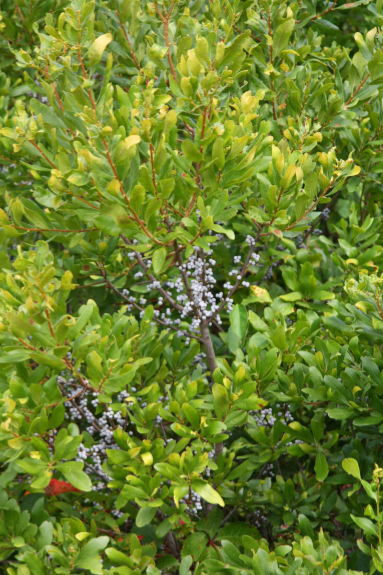- 2024 Native Trees
- >
- Shrubs
- >
- Northern Bayberry
Northern Bayberry
Northern Bayberry
(Myrica pensylvanica)
Height: 4 to 5 feet
Spread: 5 to 6 feet
Bloom Time: May
Bloom Description: Yellowish-green
Flower: Insignificant
Sun: Full sun to part shade
Fruit: Showy
Suggested Use: Hedge and Rain Garden
Tolerate: Drought, Erosion, Wet Soil , Salt, Deer
Native to: Jefferson County
If you burn your candle at both ends this low maintenance shrub is for you as the waxy berries are used to make candles.
Native to Jefferson County this dense branching shrub has a rounded habit and is typically grows along waterways including the eastern seashore.
When added to the landscape the Northern Bayberry can tolerate a wide range of soils and is often desired for along roadways that experience winter salt spray. This stout and sturdy shrub will colonize if left unchecked. Northern Bayberry has a symbiotic relationship with actinobacterium which fixes atmospheric nitrogen.
The Northern Bayberry is a dioecious species with separate male and female plants. Only the females produce berries. The shrubs offered in the Jefferson Soil and Water Conservation District Native Plant Sale are unsexed shrubs, so it is recommended to buy multiple shrubs. The female flowers, if pollinated, produce a small grayish-white berry like drupe in late summer that persists until April.
American colonists boiled the berries to extract the sweet-smelling wax, which they used to make clean-burning candles. Peter Henderson wrote in Handbook of Plants, 1890: "In New England, the wax which invests the berries is collected in considerable quantities. It is obtained by boiling the berries in water, when the wax melts and rises to the surface. Under the name of Bayberry tallow it is often used to make candles, either alone or mixed with tallow; it is also employed in soap making."
Deer find the Northern Bayberry to be quite objectionable. Whereas, the fruits are attractive to birds and small mammals. The berries are noted for helping to get Chickadees through the winter when food sources are scarce. The Northern Bayberry is a host to 9 species of butterflies and moths. ■





